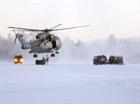Whirlybird whiteout as commando aviators get used to Arctic conditions
Disappearing in swirling clouds of white snow are the Merlins and Wildcats of Commando Helicopters as they hone their winter warrior skills in the Arctic wilds.
Three troop-carrying Merlins, and four Wildcats (three battlefield variants, one maritime model more used to operating from frigates and destroyers) are supporting hundreds of Royal Marines on the ground for two months of training deep inside the Arctic Circle.
After acclimatising – or for Arctic veterans re-acclimatising – to temperatures down to -25 Celsius and getting used to living/surviving in such a harsh environment, the air and ground crew of 845 and 847 Naval Air Squadron are now operating alongside the Royal Marines of 3 Commando Brigade, who’ve been in Norway since the beginning of the year.
The two squadrons staged a Top Gear-esque race to get to Norway – the Merlins hopping from Yeovilton to their winter base at Bardufoss over five days using civilian and military airfields on the way to rest/refuel.
The smaller Wildcats can fit in an RAF C-17 Globemaster transporter – although they need to be prepared for shipping in the UK, then ‘reassembled’ and checked at their destination.
They had the helicopters stripped down for shipping by the RAF in just three hours, then a four-hour flight to Norway and reassembly, followed by six hours work on Norwegian ‘soil’ to ready the Wildcats for renewed flying.
Despite the efficiency of the 847 operation, the Wildcats arrived in Norway 24 hours after their Merlin comrades.
There are now eight hours of daylight in Bardufoss – around 200 miles inside the Arctic Circle - but even with lengthening days, temperatures by day can be as low as 11 degrees below zero.
The entire exercise area – a mix of mountains, valleys and frozen lakes – is blanketed in snow which may give the region a ‘winter wonderland’ vista, but poses dangers to the aircrew.
As either a Wildcat or Merlin comes into land it stirs up the fine snow into a blizzard or whiteout – the technical term is recirculation – which engulfs the helicopter in the final seconds before touchdown.
With the cockpit team deprived of all visual references (officially a ‘Degraded Visual Environment’), it falls to the aircrewman (or men in the Merlins) to guide the helicopters in safely in those crucial final seconds:
Snow cloud building.
At the tail.
At the sponson.
With you.
The powerful downwash from the Merlin especially creates a wall of fine snow perhaps 50ft high and a good 200ft in diameter.
Protecting themselves against this ‘manmade snowstorm’ also forces any waiting marines on the ground to form an ‘Arctic huddle’.
The huddle is not merely to shield the marines from the snow crystals whirling around with tremendous force. Amid the mass of white, the group of tightly-packed commandos serve as a vital reference point for the pilots.
“When we are picking up troops from out on the ground very often there is no reference to fly to,” explained Merlin pilot Lieutenant Andy Duffield.
“If we are in heavy recirculation conditions – after a fresh dump of snow – due to visibility reducing to a matter of metres in the final stages of the approach we fly directly to the Arctic huddle, landing only one to two metres away from the troops.”
Which demands nerves of steel on both sides.
The helicopter training – known as Exercise Clockwork – is a precursor to the largest international military exercise Norway has led in 30 years, Cold Response 2022, involving 35,000 military personnel from 28 nations.
Royal Marines are spearheading UK involvement on the ground, while HMS Prince of Wales and HMS Albion lead the maritime participation. In all, more than 2,500 RN/RM/RFA personnel are taking part in Cold Response, which runs for most of March.





